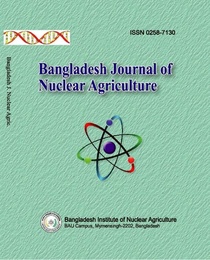IN VITRO DEVELOPMENT OF DROUGHT TOLERANT RICE THROUGH POLYETYLENE GLYCOL (PEG) USING EMBRYOGENIC CALLI
Abstract
Selection for drought resistance is gaining more importance in rice (Oryza sativa L.) but selection under natural field conditions is tiresome due to low heritability and time required. Selection in tissue culture is thought to be the preferred way to accelerate selection efficiency. Several parameters such as seed germination percentage, callus induction, shoot regeneration and root induction was studied under drought stress imposed by polyetylene glycol (PEG 6000). Rice varieties Binadhan-19 and Binadhan-17 showed significant callus induction. Callus induction was significantly higher under dark condition (85.2%) than light condition (75.83%). After callus induction, drought stress was created by increased levels of PEG (0%, 5%, 8% and 10%). The highest and the lowest percentage of plant regeneration were found in both varieties at 0% and 10% PEG. The variety Binadhan-19 performed best at 5.0% PEG for shoot regeneration (64%) and root induction (60%) followed by 8% and 10% PEG. At 8% PEG level, shoot regeneration was 56% in Binadhan-19 and 40% in Binadhan-17 and root induction was 40% in Binadhan-19 and 30% in Binadhan-17. At 10% PEG level, shoot regeneration was 40% in Binadhan-19 and 32% in Binadhan-17 and root induction was 30% in Binadhan-19 and 20% in Binadhan-17. The variety Binadhan-19 performed better against drought stress than Binadhan-17. These results emphasize that, selection of drought tolerant rice plants in vitro by creating artificial water stress using PEG in culture media is feasible. The information gained from the study could be helpful in developing rice varieties in vitro for drought tolerance.
References
Akram, H.M., Ali, A., Sattar, A., Rehman, H.S.U. and Bibi, A. 2013. Impact of water deficit stress on various physiological and agronomic traits of three basmati rice (Oryza sativa L.) varieties. J Anim Plant Sci, 23(5): 1415-1423.
Akter, J., Yasmin, S., Bhuiyan, M.J.H., Khatun, F., Roy J. and Goswami, K. 2016. In vitro screening of rice genotypes using polyethylene glycol under drought stress.Progressive Agriculture, 27(2): 128-135.
BBS (Bangladesh Bureau of Statistics), 2007. Year Book of Agricultural Statistics of Bangladesh Stat. Div. Minis. Planning, Govt. People's Repub. Bangladesh.
FAO (Food and Agriculture Organization), 2003. Production Year Book, Food and agriculture organizations of United Nations, Rome Italy. No. 57.
FAO (Food and Agriculture Organization). (2004). Rice is Life. Italy: FAO.
Jaleel, C.A., Manivannan, P., Lakshmanan, G.M.A., Gomathinayagam, M. and Panneerselvam, R. 2008. Alterations in morphological parameters and photosynthetic pigment responses of Catharanthus roseus under soil water deficits. Colloids and surfaces B: Bio interfaces, 61(2): 298-303.
Kaur, G., Kumar, S., Nayyar, H. and Upadhyaya, H.D. 2008. Cold stress injury during the pod filling phase in chickpea (Cicer arietinum L.): Effects on quantitative and qualitative components of seeds. Journal of agronomy and crop science, 194(6): 457-464.
Khush, G.S. 2005. What it will take to feed 5.0 billion rice consumers in 2030. Plant molecular biology, 59(1): 1-6.
Mohd Din, A.R.J., Ahmad, F.I., Wagiran, A., Samad, A.A., Rahmat, Z. andSarmidi, M.R. 2016. Improvement of efficient in vitro regeneration potential of mature callus induced from Malaysian upland rice seed (Oryza sativa cv. Panderas). Saudi Journal of Biological Sciences, 23: S69-S77.
Phung, T.H., Jung, H.I., Park, J.H., Kim, J.G., Back, K. and Jung, S. 2011. Porphyrin biosynthesis control under water stress: sustained porphyrin status correlates with drought tolerance in transgenic rice. Plant physiology, 157(4): 1746-1764.
Shahsavari, E., Maheran, A.A., Siti Nor Akmar, A. and Hanafi, M.M. 2010. The effect of plant growth regulators on optimization of tissue culture system in Malaysian upland rice. African Journal of Biotechnology, 9(14): 2089-2094
Thakur, P., Kumar, S., Malik, J. A., Berger, J.D. and Nayyar, H. 2010. Cold stress effects on reproductive development in grain crops: an overview. Environmental and Experimental Botany, 67(3): 429-443.
Tripathy, S.K. 2015. In Vitro Screening of Callus Cultures and Regenerants for Drought Tolerance in Upland Rice. Research Journal of Biotechnology, 10(6): 23-28.
Wani, S.H., Sofi, P.A., Gosal, S.S. and Singh, N.B. 2010. In vitro screening of rice (Oryza sativa L) callus for drought tolerance. Communications in Biometry and Crop Science, 5(2): 108-115.
-
Download



